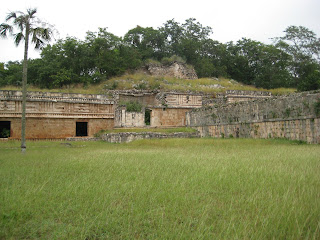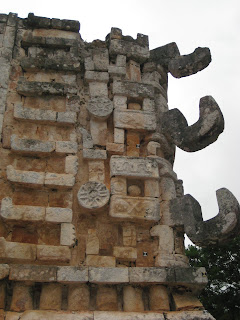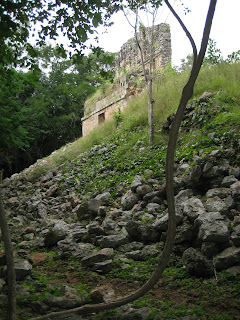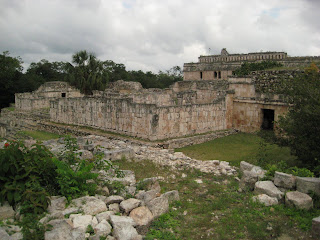 So while in Merida, I was able to take a day-trip to Chichen Itza ("Mouth of the Well of the Itza")!! I was so excited but unfortunately, I cannot share all of the photos I have of this amazing Maya site! There were so many people here and our tour guide wasn't exactly magnanimous in dispensing the information he had about Chichen, but I have studied a little bit about this interesting city so it really wasn't too big of a deal. The group of 12 or 13 people that we were in were all English speaking so the tour was in English but I would only speak with our guide in Spanish (which may have annoyed him-I don't know!). Chichen probably flourished between 850CE-1150CE which puts it at the end of the Classic period and the beginning of the PostClassic. It is an enormous site covering over 6sq miles!! The Itza (a group of Maya-although, as I have posted before, some scholars say that the Itza were not an ethnic group but rather a group of people that shared their common worship of the Feathered Serpent much like Muslims believe in Muhammed and Islam or Christians believe in Christ and Christianity- they could have been different peoples from various regions of Mesoamerica) may have been motivated to occupy this area because of the north salt beds and their related long-distance trade routes. Really there are three different styles of people or regions here at Chichen (the Puuc, the Itza, and central Mexican influences). Many scholars have written about the similarities between Chichen Itza and the central Mexican site of Tula, home of the Tolteca (who the Tenochca Mexica venerated and described as very tall, literate, artistic, and civilized peoples). Chichen has so many different buildings and archaeologists have been studying this site for well over a hundred years! I have included a picture of El Caracol, the observatory at Chichen which has connections with the planet Venus (which connects this building with war), a picture of the scribal residence at Chichen-with our tour guide in front of it- which has particular interest for me, and some of the buildings with more Puuc-like iconography. This place did not disappoint and I really enjoyed being able to come here. What a grateful and lucky person I am for the places and sites that I have been able to see while in Mexico!!
So while in Merida, I was able to take a day-trip to Chichen Itza ("Mouth of the Well of the Itza")!! I was so excited but unfortunately, I cannot share all of the photos I have of this amazing Maya site! There were so many people here and our tour guide wasn't exactly magnanimous in dispensing the information he had about Chichen, but I have studied a little bit about this interesting city so it really wasn't too big of a deal. The group of 12 or 13 people that we were in were all English speaking so the tour was in English but I would only speak with our guide in Spanish (which may have annoyed him-I don't know!). Chichen probably flourished between 850CE-1150CE which puts it at the end of the Classic period and the beginning of the PostClassic. It is an enormous site covering over 6sq miles!! The Itza (a group of Maya-although, as I have posted before, some scholars say that the Itza were not an ethnic group but rather a group of people that shared their common worship of the Feathered Serpent much like Muslims believe in Muhammed and Islam or Christians believe in Christ and Christianity- they could have been different peoples from various regions of Mesoamerica) may have been motivated to occupy this area because of the north salt beds and their related long-distance trade routes. Really there are three different styles of people or regions here at Chichen (the Puuc, the Itza, and central Mexican influences). Many scholars have written about the similarities between Chichen Itza and the central Mexican site of Tula, home of the Tolteca (who the Tenochca Mexica venerated and described as very tall, literate, artistic, and civilized peoples). Chichen has so many different buildings and archaeologists have been studying this site for well over a hundred years! I have included a picture of El Caracol, the observatory at Chichen which has connections with the planet Venus (which connects this building with war), a picture of the scribal residence at Chichen-with our tour guide in front of it- which has particular interest for me, and some of the buildings with more Puuc-like iconography. This place did not disappoint and I really enjoyed being able to come here. What a grateful and lucky person I am for the places and sites that I have been able to see while in Mexico!!




Here is El Castillo! This pyramid is absolutely fascinating and I was readily impressed by its structure, its size, its iconography and the fact that it is a three-dimensional calendar! I couldn't wait to see this one! I really wish that I could have climbed up and seen the temple that sits atop El Castillo but unfortunately, an elderly man tumbled to the ground and died back in 2005; since then, no one is allowed to climb up to this pyramid's zenith. Anyways, this 75foot high pyramid does have central Mexican influences, but also contains several Maya characteristics, including a nine-terraced element found in other Maya pyramids (at other sites). El Castillo has another name: the Temple-Pyramid of Kukulcan (the Mayan word for feathered serpent-Quetzalcoatl is the name utilized by ancient central Mexican

cultures). The association of Kukulcan with this building is quite obvious (and specifically quite fascinating for me!). I have included a picture of me in front of the Temple of 1000 columns because that's an interesting edifice (and again, you can't climb it!). This temple is strikingly similar to Pyramid B at Tula (Central Mexico- the Toltec site- this temple at Chichen has images and masks of Chac, the Maya rain god, while at Tula, only atlantean supports remain and the temple is gone).





The ubiquity of the feathered serpent at Chichen Itza, although not surprising (because I already knew that the feathered serpent abounds everywhere at Chichen), was almost startling. Even though professors told me that the feathered serpent is literally everywhere, I wasn't ready for the constant images and iconography. The feathered serpent is literally an interpretation of a pair of iconographic motifs that have been consistently linked from the Formative Period on (the Formative being from 2000BCE-300CE although there are smaller subsets found within this larger, general chronology). The pair of elements consists of a serpent bearing a crest of feathers (scales that had feathers as well) or a serpent paired with the quetzal bird. Even the Olmeca had images of a plumed serpent who represented fertility and wealth. There are copious articles and books about this imagery and about the feathered serpent; he almost has his own type of genre in Mesoamerican literature and academic research. Anyways, Chichen is a fascinating site because of the importance of the feathered serpent.




Here are some pictures of the iconographic elements that adorn several buildings at Chichen. The tzompantli (zom-paant-lee) is the skullrack shown but several scholars have written about skullracks that were comprised of actual skulls (evidence from central Mexico- in fact, the word tzompantli is a Nahuatl word, not from a Mayan language). The eagle and the jaguar iconography is very important to many civilizations in Mesoamerica. At Chichen, these powerful animals are shown eating hearts, signifying the importance of sacrifice at Chichen. And, of course, I had to include a picture of the magnificent and gargantuan ballcourt at Chichen. The ballgame was not uniform or homogeneous in its rules, systems of play, clothing used, etc. Many people continue to talk about the ballgame as if it were the same for all Mesoamerican peoples (but it is not- also, ballcourts have been found in different countries in the Carribean so elements of the game obviously expanded beyond Mesoamerica).





And here are some pictures from within the largest ballcourt I have ever seen! And I believe that this ballcourt is actually the largest in all of Mesoamerica. Overall, there are 13 (I think!) ballcourts to be found at Chichen; obviously, it carried great importance and weight for not only the ancient Maya, but for virtually all ancient Mesoamerican cultures. I particularly like the iconographic elements found on the low-lying walls that form the ballcourt. For example, the skulls that are found within what appears to be the ball; the decapitated head that shoots out seven different snakes (in this example, they represent fertility-the decapitated player's head, and the ballgame itself, represent part of the larger cosmological beliefs- the reasons why the ancient Maya played the ballgame in the first place (of course, there are several!!)). And the feathered serpent is literally ubiquitous at Chichen and I have never before seen so many images of this particular serpent at just one site (not that I've been to soooo many archaeological sites in Mexico, but I have been to various places and never seen so many feathered serpents! At Teotihuacan, the feathered serpent has his own small pyramid and at Xochicalco, he also has his own building-another pyramid- but here at Chichen, the feathered serpent is dominant in every phase of constructing the site, in every major and minor building- it's quite amazing!).







 cultures). The association of Kukulcan with this building is quite obvious (and specifically quite fascinating for me!). I have included a picture of me in front of the Temple of 1000 columns because that's an interesting edifice (and again, you can't climb it!). This temple is strikingly similar to Pyramid B at Tula (Central Mexico- the Toltec site- this temple at Chichen has images and masks of Chac, the Maya rain god, while at Tula, only atlantean supports remain and the temple is gone).
cultures). The association of Kukulcan with this building is quite obvious (and specifically quite fascinating for me!). I have included a picture of me in front of the Temple of 1000 columns because that's an interesting edifice (and again, you can't climb it!). This temple is strikingly similar to Pyramid B at Tula (Central Mexico- the Toltec site- this temple at Chichen has images and masks of Chac, the Maya rain god, while at Tula, only atlantean supports remain and the temple is gone). 



 The ubiquity of the feathered serpent at Chichen Itza, although not surprising (because I already knew that the feathered serpent abounds everywhere at Chichen), was almost startling. Even though professors told me that the feathered serpent is literally everywhere, I wasn't ready for the constant images and iconography. The feathered serpent is literally an interpretation of a pair of iconographic motifs that have been consistently linked from the Formative Period on (the Formative being from 2000BCE-300CE although there are smaller subsets found within this larger, general chronology). The pair of elements consists of a serpent bearing a crest of feathers (scales that had feathers as well) or a serpent paired with the quetzal bird. Even the Olmeca had images of a plumed serpent who represented fertility and wealth. There are copious articles and books about this imagery and about the feathered serpent; he almost has his own type of genre in Mesoamerican literature and academic research. Anyways, Chichen is a fascinating site because of the importance of the feathered serpent.
The ubiquity of the feathered serpent at Chichen Itza, although not surprising (because I already knew that the feathered serpent abounds everywhere at Chichen), was almost startling. Even though professors told me that the feathered serpent is literally everywhere, I wasn't ready for the constant images and iconography. The feathered serpent is literally an interpretation of a pair of iconographic motifs that have been consistently linked from the Formative Period on (the Formative being from 2000BCE-300CE although there are smaller subsets found within this larger, general chronology). The pair of elements consists of a serpent bearing a crest of feathers (scales that had feathers as well) or a serpent paired with the quetzal bird. Even the Olmeca had images of a plumed serpent who represented fertility and wealth. There are copious articles and books about this imagery and about the feathered serpent; he almost has his own type of genre in Mesoamerican literature and academic research. Anyways, Chichen is a fascinating site because of the importance of the feathered serpent.













 And then finally, we were able to go and have lunch (it was a buffet that had quite a bit of vegetarian food) while these dancers performed for us. They were all very friendly and quite talented, I might add. I know that I cannot dance with an empty bottle on the top of my head. But of course, people starting saying that one needs to drink whatever is in that bottle in order to be able to do that! Then we went to a cenote and there were tons of people swimming, diving off of rocks, and enjoying this break from the hot, humid day!! All in all, the day was exciting (particularly for me) because I have heard so much about Chichen Itza for years and to have finally been able to visit this site was truly a wonderful experience and one that I will not forget!
And then finally, we were able to go and have lunch (it was a buffet that had quite a bit of vegetarian food) while these dancers performed for us. They were all very friendly and quite talented, I might add. I know that I cannot dance with an empty bottle on the top of my head. But of course, people starting saying that one needs to drink whatever is in that bottle in order to be able to do that! Then we went to a cenote and there were tons of people swimming, diving off of rocks, and enjoying this break from the hot, humid day!! All in all, the day was exciting (particularly for me) because I have heard so much about Chichen Itza for years and to have finally been able to visit this site was truly a wonderful experience and one that I will not forget!



































